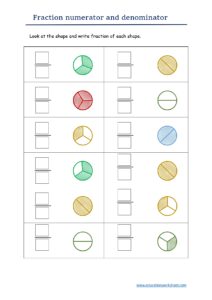Get 20 Worksheets Numerator and Denominator of Fractions
Numerator and Denominator
Understanding the Crucial Elements of Fractions: The Numerator and Denominator
Fractions are a fundamental concept in mathematics, serving as a bridge between whole numbers and more precise representations of quantities. At the heart of any fraction lie two critical components: the numerator and the denominator. In this comprehensive exploration, we delve deep into these foundational elements to demystify the world of fractions.
1. Numerator – Unraveling the “How Many” Component:
- The numerator is the upper part of a fraction, seemingly modest in its placement but carrying profound significance. It essentially answers the question, “How many parts are we considering out of the whole?”
- In practice, the numerator represents the quantity or count of equal parts you have or wish to express. It’s your way of specifying the precise portion of the whole you’re interested in.
- For instance, in the fraction 3/5, the numerator is 3. This signifies that you are considering or have three equal parts of the whole
- The numerator is the numerical hero of the fraction, situated prominently at the top. It’s not just a number; it’s a count, telling us precisely “how many” parts or units we are considering.
- Picture a pizza sliced into multiple pieces. If you have devoured three of those slices, then in fraction form, the numerator is 3. It articulates that you possess three pieces out of the total slices under consideration.
-

Numerator and Denominator - Numerator and Denominator
- .
2. Denominator – Defining the “Whole” Component:
- Contrasting its counterpart, the denominator is the lower part of the fraction, often overlooked but equally indispensable. It tells you the total number of equal parts into which the whole is divided or can be divided.
- In essence, the denominator defines the unit or whole that serves as the basis for your fraction. It answers the question, “How many parts make up the whole?”
- Taking our previous example, in the fraction 3/5, the denominator is 5. This indicates that the whole is divided into five equal parts.
Understanding the interplay between the numerator and denominator is pivotal in comprehending fractions. Together, they articulate the concept of possessing a specific number of parts (numerator) out of a specified total (denominator). This seemingly simple representation finds extensive applications across various fields, from mathematics and science to everyday activities like cooking, construction, and financial calculations.
Whether you’re an educator guiding students through the intricacies of fractions or an individual seeking to fortify your mathematical foundation, mastering the roles of numerator and denominator is a pivotal step. These fundamental components not only facilitate basic fraction operations but also provide the groundwork for tackling more advanced mathematical challenges with precision and confidence. Explore the world of fractions with clarity and certainty as you unlock the potential of these essential elements.
These two components are inseparable in a fraction.
Together, they define the relationship between parts and the whole, giving fractions their expressive power. From baking recipes that require precise measurements to engineering blueprints that demand accuracy, fractions are employed extensively in various real-world applications.
Whether you’re helping a young learner embark on their mathematical journey or refreshing your own knowledge, understanding the nuanced interplay between the numerator and denominator is pivotal. It’s the first step towards mastering more advanced fraction operations like addition, subtraction, multiplication, and division, and it empowers you to confidently tackle complex problem-solving tasks across multiple domains.So, dive into this comprehensive guide, unlock the secrets of numerators and denominators, and embark on a journey to harness the full potential of fractions in your mathematical endeavors. Nestled gracefully at the bottom of the fraction, the denominator plays a complementary yet equally vital role. It communicates the total number of equal parts into which a whole is divided.

